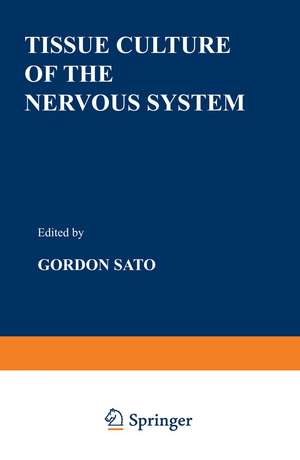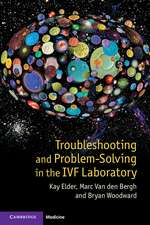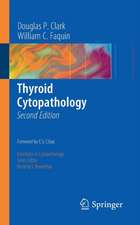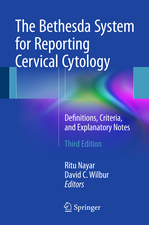Tissue Culture of the Nervous System: Current Topics in Neurobiology
Editat de Gordon Satoen Limba Engleză Paperback – 26 mar 2012
Preț: 358.08 lei
Preț vechi: 376.93 lei
-5% Nou
Puncte Express: 537
Preț estimativ în valută:
68.52€ • 72.07$ • 57.26£
68.52€ • 72.07$ • 57.26£
Carte tipărită la comandă
Livrare economică 08-22 ianuarie 25
Preluare comenzi: 021 569.72.76
Specificații
ISBN-13: 9781468429060
ISBN-10: 146842906X
Pagini: 308
Ilustrații: XIV, 288 p.
Dimensiuni: 152 x 229 x 16 mm
Greutate: 0.41 kg
Ediția:1973
Editura: Springer Us
Colecția Springer
Seria Current Topics in Neurobiology
Locul publicării:New York, NY, United States
ISBN-10: 146842906X
Pagini: 308
Ilustrații: XIV, 288 p.
Dimensiuni: 152 x 229 x 16 mm
Greutate: 0.41 kg
Ediția:1973
Editura: Springer Us
Colecția Springer
Seria Current Topics in Neurobiology
Locul publicării:New York, NY, United States
Public țintă
ResearchCuprins
1 Long-Term Cultures of Embryonic and Mature Insect Nervous and Neuroendocrine Systems.- I. Introduction.- II. The Object of Choice: Periplaneta americana.- III. Material and Techniques.- IV. Specific Problems.- V. Concluding Remarks and Perspectives.- VI. References.- 2 Differentiation of Aggregating Brain Cell Cultures.- I. Introduction.- II. Aggregation.- III. Migration.- IV. Biochemical Differentiation.- V. Morphological Differentiation.- VI. Prospectus.- VII. Acknowledgments.- VIII. References.- 3 Differentiation and Interaction of Clonal Cell Lines of Nerve and Muscle.- I. Introduction.- II. Origin of Cell Lines.- III. Morphological Differentiation.- IV. Chemical Differentiation.- V. Electrical Differentiation.- VI. Differentiation and Cell Culture.- VII. Tropic Interaction Between Neuroblastoma and Myoblast Cell Lines.- VIII. Summary.- IX. References.- 4 Biochemical Characterization of a Clonal Line of Neuroblastoma.- I. Introduction.- II. Nucleic Acid and Protein Content.- III. RNA Biosynthesis.- IV. Protein Biosynthesis.- V. Glycoproteins of the Cell Surface.- VI. Discussion.- VII. References.- 5 Regulation of Neuronal Enzymes in Cell Culture.- I. Introduction.- II. Dissociated Primary Mouse Brain Cultures.- III. Neuroblastoma C1300 Ajax Mouse Cells in Culture.- IV. Neuroblast-Glioblast Biochemical Relationships.- V. Speculation.- VI. References.- 6 Electrophysiological Studies of Normal and Neoplastic Cells in Tissue Culture.- I. Introduction.- II. The Mouse C1300 Neuroblastoma.- III. Hybrid Cell Lines.- IV. Other Continuous Cell Lines: Electrical Coupling.- V. Normal Dissociated Cultures.- VI. References.- 7 Genetic Analysis of the Mammalian Nervous System Using Somatic Cell Culture Techniques.- I. General Methods for Genetic Analysis of the Nervous System.-II. Mitotic Inheritance of Differentiated Functions.- III. Hybridization Experiments.- IV. Generation of Propagating Cell Lines from Normal Neurons and Glia.- V. Conclusions and Future Forecast.- VI. Acknowledgments.- VII. References.- 8 Nervous System-Specific Proteins in Cultured Neural Cells.- I. Introduction.- II. Experimental Neural Tumors.- III. S100 Protein Production by C6 Rat Glial Cells.- IV. Synthesis and Degradation of S100 Protein in C6 Cells.- V. Production of 14-3-2 Protein by Human Neuroblastoma Cells in Culture.- VI. Conclusions.- VII. Acknowledgments.- VIII. References.- 9 Clonal Lines of Glial Cells.- I. Introduction.- II. Isolation of Clonal Lines.- III. Cellular Location of S100 Protein.- IV. Studies of Myelination in Vitro.- V. Prospectus.- VI. References.- 10 Induction of Enzymes by Glucocorticoids and Catecholamines in a Rat Glial Cell Line.- I. Introduction.- II. Materials and Methods.- III. Induction of Glycerol Phosphate Dehydrogenase by Cortisol.- IV. Effect of Catecholamines on Cyclic AMP and Lactic Dehydrogenase.- V. Differential Sensitivity of GPDH and LDH Inductions to Inhibitors of RNA Synthesis.- VI. Conclusions.- VII. References.- 11 The Metabolism of Glycosphingolipids and Glycosaminoglycans.- I. Introduction.- II. Glycosphingolipids.- III. Glycosaminoglycans.- IV. Collagen Synthesis.- V. Conclusions.- VI. References.












